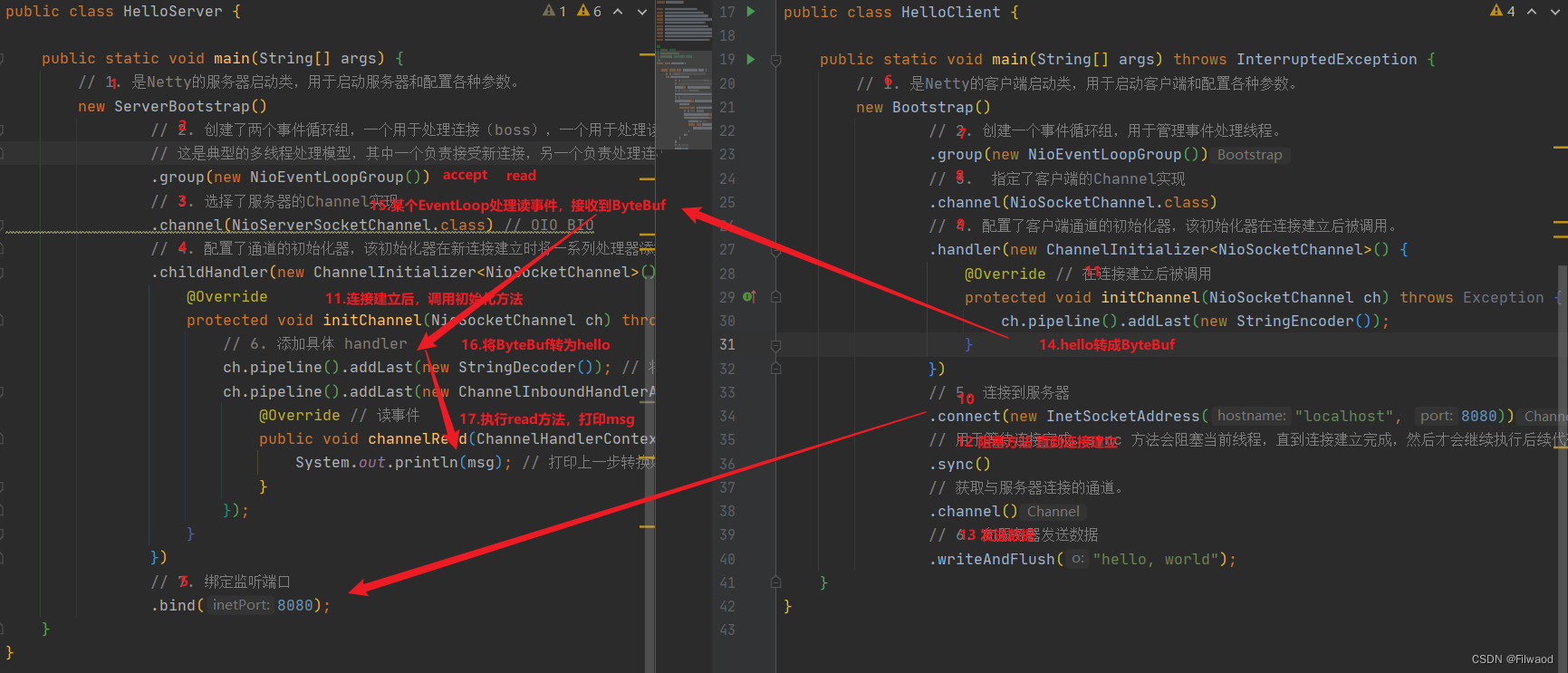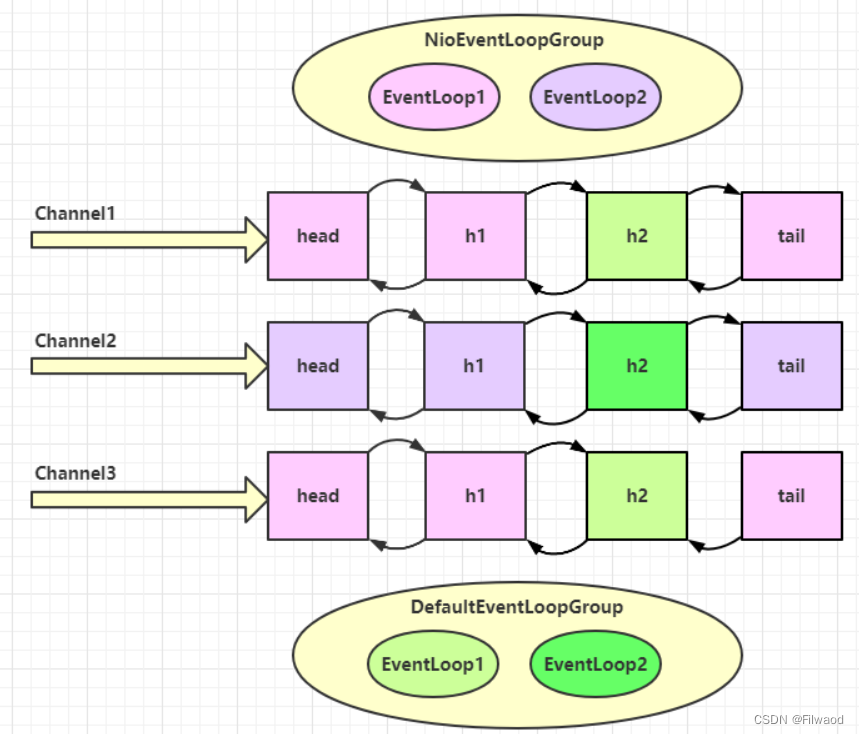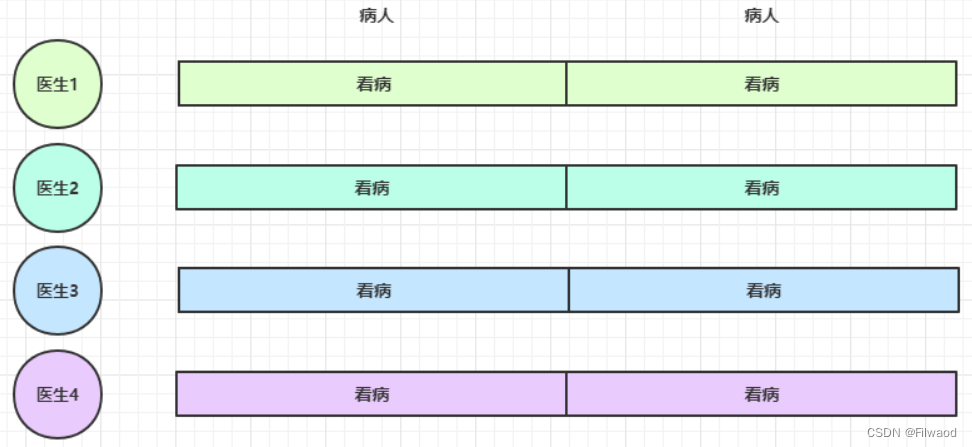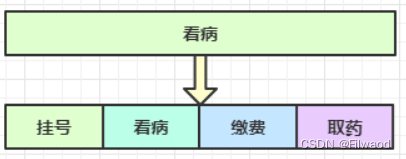Netty入门
1. 概述
1.1 Netty 是什么?
Netty 是一个异步的、基于事件驱动的网络应用框架,用于快速开发可维护、高性能的网络服务器和客户端
1.2 Netty 的地位
Netty 在 Java 网络应用框架中的地位就好比:Spring 框架在 JavaEE 开发中的地位
以下的框架都使用了 Netty,因为它们有网络通信需求!
- Cassandra - nosql 数据库
- Spark - 大数据分布式计算框架
- Hadoop - 大数据分布式存储框架
- RocketMQ - ali 开源的消息队列
- ElasticSearch - 搜索引擎
- gRPC - rpc 框架
- Dubbo - rpc 框架
- Spring 5.x - flux api 完全抛弃了 tomcat ,使用 netty 作为服务器端
- Zookeeper - 分布式协调框架
1.3 Netty 的优势
Netty 是一个高性能、异步事件驱动的网络应用框架,它在网络编程领域具有多方面的优势:
-
高性能:Netty 的设计目标之一是提供高性能的网络通信,它采用了异步、非阻塞的事件驱动模型,使其能够处理大量并发连接,而不会导致线程爆炸问题。这使得 Netty 在高负载情况下能够保持卓越的性能。
-
零拷贝:Netty 支持零拷贝技术,可以直接在内存中传递数据,减少了数据拷贝的开销,提高了数据传输的效率。这对于高吞吐量应用程序非常重要,如文件传输、流媒体处理等。
-
异步编程:Netty 基于事件驱动的模型,支持异步编程,使得开发者能够编写高效的非阻塞代码,而不需要手动管理线程,从而简化了编程模型。
-
灵活性:Netty 提供了丰富的组件和模块,可以轻松地构建各种类型的网络应用,包括TCP、UDP、HTTP、WebSocket等。它的组件化设计允许您选择性地添加或删除功能组件,以满足特定应用的需求。
总之,Netty 是一个强大的网络应用框架,它的性能、灵活性和可扩展性使其成为构建高性能网络应用的首选工具之一。无论是开发高吞吐量的服务器还是实时通信应用,Netty 都具有显著的优势。
2. Hello World
2.1 目标
开发一个简单的服务器端和客户端
- 客户端向服务器端发送 hello, world
- 服务器仅接收,不返回
加入依赖
<dependency>
<groupId>io.netty</groupId>
<artifactId>netty-all</artifactId>
<version>4.1.39.Final</version>
</dependency>
2.2 服务器端
public class HelloServer {
public static void main(String[] args) {
// 1. 是Netty的服务器启动类,用于启动服务器和配置各种参数。
new ServerBootstrap()
// 2. 创建了两个事件循环组,一个用于处理连接(boss),一个用于处理读写(worker)。
// 这是典型的多线程处理模型,其中一个负责接受新连接,另一个负责处理连接上的数据。
.group(new NioEventLoopGroup())
// 3. 选择了服务器的Channel实现
.channel(NioServerSocketChannel.class) // OIO BIO
// 4. 配置了通道的初始化器,该初始化器在新连接建立时将一系列处理器添加到通道的处理管道中,决定了 worker(child) 能执行哪些操作(handler)
.childHandler(new ChannelInitializer<NioSocketChannel>() {
@Override
protected void initChannel(NioSocketChannel ch) throws Exception {
// 6. 添加具体 handler
ch.pipeline().addLast(new StringDecoder()); // 将 ByteBuf 转换为字符串
ch.pipeline().addLast(new ChannelInboundHandlerAdapter() { // 自定义 handler
@Override // 读事件
public void channelRead(ChannelHandlerContext ctx, Object msg) throws Exception {
System.out.println(msg); // 打印上一步转换好的字符串
}
});
}
})
// 7. 绑定监听端口
.bind(8080);
}
}
2.3 客户端
public class HelloClient {
public static void main(String[] args) throws InterruptedException {
// 1. 是Netty的客户端启动类,用于启动客户端和配置各种参数。
new Bootstrap()
// 2. 创建一个事件循环组,用于管理事件处理线程。
.group(new NioEventLoopGroup())
// 3. 指定了客户端的Channel实现
.channel(NioSocketChannel.class)
// 4. 配置了客户端通道的初始化器,该初始化器在连接建立后被调用。
.handler(new ChannelInitializer<NioSocketChannel>() {
@Override // 在连接建立后被调用
protected void initChannel(NioSocketChannel ch) throws Exception {
ch.pipeline().addLast(new StringEncoder());
}
})
// 5. 连接到服务器
.connect(new InetSocketAddress("localhost", 8080))
// 用于等待连接完成。sync 方法会阻塞当前线程,直到连接建立完成,然后才会继续执行后续代码。
.sync()
// 获取与服务器连接的通道。
.channel()
// 6. 向服务器发送数据
.writeAndFlush("hello, world");
}
}
2.4 流程梳理

💡 提示
一开始需要树立正确的观念
- 把 channel 理解为数据的通道
- 把 msg 理解为流动的数据,最开始输入是 ByteBuf,但经过 pipeline 的加工,会变成其它类型对象,最后输出又变成 ByteBuf
- 把 handler 理解为数据的处理工序
- 工序有多道,合在一起就是 pipeline,pipeline 负责发布事件(读、读取完成…)传播给每个 handler, handler 对自己感兴趣的事件进行处理(重写了相应事件处理方法)
- handler 分 Inbound 和 Outbound 两类
- 把 eventLoop 理解为处理数据的工人
- 工人可以管理多个 channel 的 io 操作,并且一旦工人负责了某个 channel,就要负责到底(绑定)
- 工人既可以执行 io 操作,也可以进行任务处理,每位工人有任务队列,队列里可以堆放多个 channel 的待处理任务,任务分为普通任务、定时任务
- 工人按照 pipeline 顺序,依次按照 handler 的规划(代码)处理数据,可以为每道工序指定不同的工人
3. 组件
3.1 EventLoop
事件循环对象 EventLoop
EventLoop 本质是一个单线程执行器(同时维护了 Selector,可以是多个),里面有 run 方法处理 Channel 上源源不断的 io 事件。在网络编程中,每个连接通常都会分配一个关联的 EventLoop,用于处理该连接的读写操作,以确保异步和非阻塞的处理。
它的继承关系比较复杂
- 一条线是继承自 j.u.c.ScheduledExecutorService 因此包含了线程池中所有的方法
- 另一条线是继承自 netty 自己的 OrderedEventExecutor,
- 提供了 boolean inEventLoop(Thread thread) 方法判断一个线程是否属于此 EventLoop
- 提供了 parent 方法来看看自己属于哪个 EventLoopGroup
事件循环组 EventLoopGroup
Channel通常会被注册到底层的选择器(selector),而选择器会与EventLoop相关联,以处理I/O事件。
- EventLoopGroup 是一个抽象的概念,代表一组 EventLoop 对象。通常,每个 EventLoop 都在一个独立的线程中运行,用于处理事件和任务。
- 一个典型的应用程序会创建一个或多个 EventLoopGroup,通常分为两类:Boss 和 Worker。Boss 负责接受传入的连接请求,而 Worker 负责处理已建立连接的数据传输。
- EventLoopGroup 负责管理和调度 EventLoop 对象的生命周期,确保它们能够高效地处理事件。
- 继承自 netty 自己的 EventExecutorGroup
- 实现了 Iterable 接口提供遍历 EventLoop 的能力
- 另有 next 方法获取集合中下一个 EventLoop
以一个简单的实现为例:
public static void main(String[] args) {
//设置两个线程
NioEventLoopGroup group = new NioEventLoopGroup(2);//处理io事件,普通任务,定时任务
//NioEventLoopGroup group = new DefaultEventLoopGroup(2);//处理普通任务,定时任务
System.out.println(group.next());//io.netty.channel.nio.NioEventLoop@523884b2
System.out.println(group.next());//io.netty.channel.nio.NioEventLoop@5b275dab
System.out.println(group.next());//io.netty.channel.nio.NioEventLoop@523884b2
System.out.println(group.next());//io.netty.channel.nio.NioEventLoop@5b275dab
}
如果不传线程数,默认为可用的处理器核心数量的两倍。
private static final int DEFAULT_EVENT_LOOP_THREADS = Math.max(1, SystemPropertyUtil.getInt("io.netty.eventLoopThreads", NettyRuntime.availableProcessors() * 2));
💡 优雅关闭
优雅关闭 shutdownGracefully 方法。该方法会首先切换 EventLoopGroup 到关闭状态从而拒绝新的任务的加入,然后在任务队列的任务都处理完成后,停止线程的运行。从而确保整体应用是在正常有序的状态下退出的
private EventLoopGroup bossGroup = new NioEventLoopGroup(1);
Future<?> future = bossGroup.shutdownGracefully();
future.syncUninterruptibly();//等待关闭操作完成后再继续执行其他代码
演示 NioEventLoop 处理普通任务
NioEventLoop 除了可以处理 io 事件,同样可以向它提交普通任务
@Slf4j
public class TestEventLoop {
public static void main(String[] args) {
NioEventLoopGroup group = new NioEventLoopGroup(2);
group.execute(()->{
log.info("ok1");
});
log.info("main");
}
}
结果
10:03:21 [INFO ] [main] c.i.n.e.TestEventLoop - main
10:03:21 [INFO ] [nioEventLoopGroup-2-1] c.i.n.e.TestEventLoop - ok1
可以用来执行耗时较长的任务
演示 NioEventLoop 处理定时任务
@Slf4j
public class TestEventLoop {
public static void main(String[] args) {
NioEventLoopGroup group = new NioEventLoopGroup(2);
log.info("main");
group.scheduleAtFixedRate(() -> {
log.info("hello");
}, 0, 1, TimeUnit.SECONDS);//定时任务立刻执行,每秒执行一次
}
}
结果
10:06:19 [INFO ] [main] c.i.n.e.TestEventLoop - main
10:06:19 [INFO ] [nioEventLoopGroup-2-1] c.i.n.e.TestEventLoop - hello
10:06:20 [INFO ] [nioEventLoopGroup-2-1] c.i.n.e.TestEventLoop - hello
10:06:21 [INFO ] [nioEventLoopGroup-2-1] c.i.n.e.TestEventLoop - hello
演示 NioEventLoop 处理io事件
分工细化:
- boss处理连接请求
- worker处理io请求
- group处理一下耗时请求,防止堵塞worker

服务端代码
@Slf4j
public class EventLoopServer {
public static void main(String[] args) {
NioEventLoopGroup boss = new NioEventLoopGroup(1);
NioEventLoopGroup worker = new NioEventLoopGroup(2);
//模拟处理耗时操作
DefaultEventLoopGroup group = new DefaultEventLoopGroup();
new ServerBootstrap()
.group(boss, worker)
.channel(NioServerSocketChannel.class)
.childHandler(new ChannelInitializer<SocketChannel>() {
@Override
protected void initChannel(SocketChannel ch) throws Exception {
ch.pipeline().addLast("worker", new ChannelInboundHandlerAdapter() {//这个handler用worker处理
@Override
public void channelRead(ChannelHandlerContext ctx, Object msg) throws Exception {
ByteBuf buf = (ByteBuf) msg;
log.info(buf.toString(Charset.defaultCharset()));
ctx.fireChannelRead(msg);//传给下一个handler处理
}
}).addLast(group, "other", new ChannelInboundHandlerAdapter() {//这个handler用group处理
@Override
public void channelRead(ChannelHandlerContext ctx, Object msg) throws Exception {
ByteBuf buf = (ByteBuf) msg;
log.info(buf.toString(Charset.defaultCharset()));
}
});
}
})
.bind(8080);
}
}
客户端代码
public class EventLoopClient {
public static void main(String[] args) throws InterruptedException {
Channel channel = new Bootstrap()
.group(new NioEventLoopGroup())
.channel(NioSocketChannel.class)
.handler(new ChannelInitializer<NioSocketChannel>() {
@Override // 在连接建立后被调用
protected void initChannel(NioSocketChannel ch) throws Exception {
ch.pipeline().addLast(new StringEncoder());
}
})
.connect(new InetSocketAddress("localhost", 8080))
.sync()
.channel();
System.out.println("");
}
}
测试结果
11:11:03 [INFO ] [nioEventLoopGroup-3-1] c.i.n.e.EventLoopServer - 1
11:11:03 [INFO ] [defaultEventLoopGroup-2-1] c.i.n.e.EventLoopServer - 1
11:11:24 [INFO ] [nioEventLoopGroup-3-2] c.i.n.e.EventLoopServer - 2
11:11:24 [INFO ] [defaultEventLoopGroup-2-2] c.i.n.e.EventLoopServer - 2
💡 handler 执行中如何换人?
关键代码 io.netty.channel.AbstractChannelHandlerContext#invokeChannelRead()
static void invokeChannelRead(final AbstractChannelHandlerContext next, Object msg) {
final Object m = next.pipeline.touch(ObjectUtil.checkNotNull(msg, "msg"), next);
// 下一个 handler 的事件循环是否与当前的事件循环是同一个线程
EventExecutor executor = next.executor();//下一个handler的eventloop
// 如果下一个handler的线程和当前handler的线程是同一线程就直接调用
if (executor.inEventLoop()) {
next.invokeChannelRead(m);
}
// 不是,将要执行的代码作为任务提交给下一个事件循环处理(换人)
else {
executor.execute(new Runnable() {
@Override
public void run() {
next.invokeChannelRead(m);
}
});
}
}
- 如果两个 handler 绑定的是同一个线程,那么就直接调用
- 否则,把要调用的代码封装为一个任务对象,由下一个 handler 的线程来调用
public boolean inEventLoop(Thread thread) {
return thread == this.thread;
}
3.2 Channel
channel 的主要作用
- close() 可以用来关闭 channel
- closeFuture() 用来处理 channel 的关闭
- sync 方法作用是同步等待 channel 关闭
- 而 addListener 方法是异步等待 channel 关闭
- pipeline() 方法添加处理器
- write() 方法将数据写入
- writeAndFlush() 方法将数据写入并刷出
ChannelFuture
客户端代码
@Slf4j
public class EventLoopClient {
public static void main(String[] args) throws InterruptedException {
ChannelFuture channelFuture = new Bootstrap()
.group(new NioEventLoopGroup())
.channel(NioSocketChannel.class)
.handler(new ChannelInitializer<NioSocketChannel>() {
@Override // 在连接建立后被调用
protected void initChannel(NioSocketChannel ch) throws Exception {
ch.pipeline().addLast(new StringEncoder());
}
})
.connect(new InetSocketAddress("localhost", 8080));
log.info("{}",channelFuture.channel());//1
channelFuture.sync();//2
log.info("{}",channelFuture.channel());//3
Channel channel = channelFuture.channel();
channel.writeAndFlush("123456");
}
}
注意 connect 方法是异步非阻塞的,意味着不等连接建立,方法执行就返回了。因此 channelFuture 对象中不能【立刻】获得到正确的 Channel 对象
结果:
- 执行到 1 时,连接未建立,打印
[id: 0x4bc3c5ce] - 执行到 2 时,sync 方法是同步阻塞等待连接建立完成
- 执行到 3 时,连接肯定建立了,打印
[id: 0x4bc3c5ce, L:/127.0.0.1:52563 - R:localhost/127.0.0.1:8080]
也就是如果不加channelFuture.sync();这行代码,后续代码执行的时候,可能连接还未完全建立成功,可能造成问题
15:00:45 [INFO ] [main] c.i.n.e.EventLoopClient - [id: 0x4bc3c5ce]
15:00:45 [INFO ] [main] c.i.n.e.EventLoopClient - [id: 0x4bc3c5ce, L:/127.0.0.1:52563 - R:localhost/127.0.0.1:8080]
除了用 sync 方法可以让异步操作同步以外,还可以使用回调的方式:
@Slf4j
public class EventLoopClient {
public static void main(String[] args) throws InterruptedException {
ChannelFuture channelFuture = new Bootstrap()
.group(new NioEventLoopGroup())
.channel(NioSocketChannel.class)
.handler(new ChannelInitializer<NioSocketChannel>() {
@Override // 在连接建立后被调用
protected void initChannel(NioSocketChannel ch) throws Exception {
ch.pipeline().addLast(new StringEncoder());
}
})
.connect(new InetSocketAddress("localhost", 8080));
log.info("{}", channelFuture.channel());// 1
channelFuture.addListener(new ChannelFutureListener() {
@Override
public void operationComplete(ChannelFuture channelFuture) throws Exception {
log.info("{}", channelFuture.channel());// 2
}
});
}
}
结果:
- 执行到 1 时,连接未建立,打印
[id: 0x5b45d7c1] - ChannelFutureListener 会在连接建立时被调用(其中 operationComplete 方法),因此执行到 2 时,连接肯定建立了,打印
[id: 0x5b45d7c1, L:/127.0.0.1:52855 - R:localhost/127.0.0.1:8080],但是看打印的线程可知,这个方法的执行也是异步的
15:07:47 [INFO ] [main] c.i.n.e.EventLoopClient - [id: 0x5b45d7c1]
15:07:47 [INFO ] [nioEventLoopGroup-2-1] c.i.n.e.EventLoopClient - [id: 0x5b45d7c1, L:/127.0.0.1:52855 - R:localhost/127.0.0.1:8080]
CloseFuture
两种方式:
- sync 同步处理关闭
- addListener 异步处理关闭
@Slf4j
public class EventLoopClient {
public static void main(String[] args) throws InterruptedException {
NioEventLoopGroup group = new NioEventLoopGroup();
ChannelFuture channelFuture = new Bootstrap()
.group(group)
.channel(NioSocketChannel.class)
.handler(new ChannelInitializer<NioSocketChannel>() {
@Override // 在连接建立后被调用
protected void initChannel(NioSocketChannel ch) throws Exception {
ch.pipeline().addLast(new LoggingHandler(LogLevel.DEBUG));
ch.pipeline().addLast(new StringEncoder());
}
})
.connect(new InetSocketAddress("localhost", 8080));
Channel channel = channelFuture.sync().channel();
new Thread(() -> {
Scanner scanner = new Scanner(System.in);
while (true) {
String line = scanner.nextLine();
if ("q".equals(line)) {
channel.close(); // close 异步操作 1s 之后
// log.debug("处理关闭之后的操作"); // 不能在这里善后
break;
}
channel.writeAndFlush(line);
}
}, "input").start();
// 获取 CloseFuture 对象, 1) 同步处理关闭, 2) 异步处理关闭
ChannelFuture closeFuture = channel.closeFuture();
//log.debug("waiting close...");
//closeFuture.sync();
//log.debug("处理关闭之后的操作");
closeFuture.addListener(new ChannelFutureListener() {
@Override
public void operationComplete(ChannelFuture channelFuture) throws Exception {
log.debug("处理关闭之后的操作");
group.shutdownGracefully();
}
});
}
}
同步结果:
16:44:18 [DEBUG] [nioEventLoopGroup-2-1] i.n.h.l.LoggingHandler - [id: 0x681a2e33, L:/127.0.0.1:58755 - R:localhost/127.0.0.1:8080] CLOSE
16:44:18 [DEBUG] [main] c.i.n.e.EventLoopClient - 处理关闭之后的操作
16:44:18 [DEBUG] [nioEventLoopGroup-2-1] i.n.h.l.LoggingHandler - [id: 0x681a2e33, L:/127.0.0.1:58755 ! R:localhost/127.0.0.1:8080] INACTIVE
16:44:18 [DEBUG] [nioEventLoopGroup-2-1] i.n.h.l.LoggingHandler - [id: 0x681a2e33, L:/127.0.0.1:58755 ! R:localhost/127.0.0.1:8080] UNREGISTERED
异步结果:
16:42:48 [DEBUG] [nioEventLoopGroup-2-1] i.n.h.l.LoggingHandler - [id: 0xcdb40c7a, L:/127.0.0.1:58672 - R:localhost/127.0.0.1:8080] CLOSE
16:42:48 [DEBUG] [nioEventLoopGroup-2-1] c.i.n.e.EventLoopClient - 处理关闭之后的操作
16:42:48 [DEBUG] [nioEventLoopGroup-2-1] i.n.h.l.LoggingHandler - [id: 0xcdb40c7a, L:/127.0.0.1:58672 ! R:localhost/127.0.0.1:8080] INACTIVE
16:42:48 [DEBUG] [nioEventLoopGroup-2-1] i.n.h.l.LoggingHandler - [id: 0xcdb40c7a, L:/127.0.0.1:58672 ! R:localhost/127.0.0.1:8080] UNREGISTERED
两种方式执行处理关闭之后的操作的所在线程不一样
3.3 Future&Promise
💡 异步提升的是什么
-
有些同学看到这里会有疑问:为什么不在一个线程中去执行建立连接、去执行关闭 channel,那样不是也可以吗?非要用这么复杂的异步方式:比如一个线程发起建立连接,另一个线程去真正建立连接
-
还有同学会笼统地回答,因为 netty 异步方式用了多线程、多线程就效率高。其实这些认识都比较片面,多线程和异步所提升的效率并不是所认为的
思考下面的场景,4 个医生给人看病,每个病人花费 20 分钟,而且医生看病的过程中是以病人为单位的,一个病人看完了,才能看下一个病人。假设病人源源不断地来,可以计算一下 4 个医生一天工作 8 小时,处理的病人总数是:4 * 8 * 3 = 96

经研究发现,看病可以细分为四个步骤,经拆分后每个步骤需要 5 分钟,如下

因此可以做如下优化,只有一开始,医生 2、3、4 分别要等待 5、10、15 分钟才能执行工作,但只要后续病人源源不断地来,他们就能够满负荷工作,并且处理病人的能力提高到了 4 * 8 * 12 效率几乎是原来的四倍

要点
- 单线程没法异步提高效率,必须配合多线程、多核 cpu 才能发挥异步的优势
- 异步并没有缩短响应时间,反而有所增加
- 合理进行任务拆分,也是利用异步的关键
3.3 Future & Promise
在异步处理时,经常用到这两个接口
首先要说明 netty 中的 Future 与 jdk 中的 Future 同名,但是是两个接口,netty 的 Future 继承自 jdk 的 Future,而 Promise 又对 netty Future 进行了扩展
- jdk Future 只能同步等待任务结束(或成功、或失败)才能得到结果
- netty Future 可以同步等待任务结束得到结果,也可以异步方式得到结果,但都是要等任务结束
- netty Promise 不仅有 netty Future 的功能,而且脱离了任务独立存在,只作为两个线程间传递结果的容器
| 功能/名称 | jdk Future | netty Future | Promise |
|---|---|---|---|
| cancel | 取消任务 | - | - |
| isCanceled | 任务是否取消 | - | - |
| isDone | 任务是否完成,不能区分成功失败 | - | - |
| get | 获取任务结果,阻塞等待 | - | - |
| getNow | - | 获取任务结果,非阻塞,还未产生结果时返回 null | - |
| await | - | 等待任务结束,如果任务失败,不会抛异常,后续代码需要通过 isSuccess 判断 | - |
| sync | - | 等待任务结束,如果任务失败,抛出异常 | - |
| isSuccess | - | 判断任务是否成功 | - |
| cause | - | 获取失败信息,非阻塞,如果没有失败,返回null | - |
| addLinstener | - | 添加回调,异步接收结果 | - |
| setSuccess | - | - | 设置成功结果 |
| setFailure | - | - | 设置失败结果 |
jdkFuture
@Slf4j
public class TestJdkFuture {
public static void main(String[] args) throws Exception {
ExecutorService executor = Executors.newSingleThreadExecutor();
Future<Integer> future = executor.submit(new Callable<Integer>() {
@Override
public Integer call() throws Exception {
log.info("开始计算...");
Thread.sleep(2000);
return 50;
}
});
log.info("等待结果...");
log.info("同步返回结果:" + future.get());
}
}
结果
11:20:08 [INFO ] [pool-1-thread-1] c.i.n.f.TestJdkFuture - 开始计算...
11:20:08 [INFO ] [main] c.i.n.f.TestJdkFuture - 等待结果...
11:20:10 [INFO ] [main] c.i.n.f.TestJdkFuture - 返回结果:50
nettyFuture
@Slf4j
public class TestNettyFuture {
public static void main(String[] args) throws Exception {
NioEventLoopGroup group = new NioEventLoopGroup();
Future<Integer> future = group.submit(new Callable<Integer>() {
@Override
public Integer call() throws Exception {
log.info("开始计算...");
Thread.sleep(2000);
return 50;
}
});
log.info("等待结果...");
//同步
log.info("同步返回结果:" + future.get());
//异步
future.addListener(new GenericFutureListener<Future<? super Integer>>() {
@Override
public void operationComplete(Future<? super Integer> future) throws Exception {
log.info("异步返回结果:" + future.getNow());
}
});
}
}
结果
11:37:40 [INFO ] [main] c.i.n.f.TestNettyFuture - 等待结果...
11:37:40 [INFO ] [nioEventLoopGroup-2-1] c.i.n.f.TestNettyFuture - 开始计算...
11:37:42 [INFO ] [main] c.i.n.f.TestNettyFuture - 同步返回结果:50
11:37:42 [INFO ] [nioEventLoopGroup-2-1] c.i.n.f.TestNettyFuture - 异步返回结果:50
nettyFuture
@Slf4j
public class TestNettyPromise {
public static void main(String[] args) throws ExecutionException, InterruptedException {
NioEventLoopGroup group = new NioEventLoopGroup();
DefaultPromise promise=new DefaultPromise<>(group.next());
group.execute(()->{
try {
log.info("开始计算...");
Thread.sleep(2000);
promise.setSuccess(10);
} catch (InterruptedException e) {
e.printStackTrace();
promise.setFailure(null);
}
});
log.info("等待结果...");
log.info("同步返回结果:" + promise.get());
}
}
结果
14:49:28 [INFO ] [main] c.i.n.f.TestNettyPromise - 等待结果...
14:49:28 [INFO ] [nioEventLoopGroup-2-1] c.i.n.f.TestNettyPromise - 开始计算...
14:49:30 [INFO ] [main] c.i.n.f.TestNettyPromise - 同步返回结果:10
3.4 Handler & Pipeline
ChannelHandler 用来处理 Channel 上的各种事件,分为入站、出站两种。所有 ChannelHandler 被连成一串,就是 Pipeline
- 入站处理器通常是 ChannelInboundHandlerAdapter 的子类,主要用来读取客户端数据,写回结果
- 出站处理器通常是 ChannelOutboundHandlerAdapter 的子类,主要对写回结果进行加工
打个比喻,每个 Channel 是一个产品的加工车间,Pipeline 是车间中的流水线,ChannelHandler 就是流水线上的各道工序,而后面要讲的 ByteBuf 是原材料,经过很多工序的加工:先经过一道道入站工序,再经过一道道出站工序最终变成产品
服务端
@Slf4j
public class TestPipeLineServer {
public static void main(String[] args) {
new ServerBootstrap()
.group(new NioEventLoopGroup())
.channel(NioServerSocketChannel.class)
.childHandler(new ChannelInitializer<NioSocketChannel>() {
@Override
protected void initChannel(NioSocketChannel ch) {
ch.pipeline().addLast(new ChannelInboundHandlerAdapter() {
@Override
public void channelRead(ChannelHandlerContext ctx, Object msg) {
System.out.println(1);
ctx.fireChannelRead(msg); // 1
}
});
ch.pipeline().addLast(new ChannelInboundHandlerAdapter() {
@Override
public void channelRead(ChannelHandlerContext ctx, Object msg) {
System.out.println(2);
ctx.fireChannelRead(msg); // 2
}
});
ch.pipeline().addLast(new ChannelInboundHandlerAdapter() {
@Override
public void channelRead(ChannelHandlerContext ctx, Object msg) {
System.out.println(3);
//ch.writeAndFlush(msg);
ctx.channel().writeAndFlush(msg); // 3
}
});
ch.pipeline().addLast(new ChannelOutboundHandlerAdapter() {
@Override
public void write(ChannelHandlerContext ctx, Object msg,
ChannelPromise promise) {
System.out.println(4);
ctx.writeAndFlush(msg, promise); // 4
}
});
ch.pipeline().addLast(new ChannelOutboundHandlerAdapter() {
@Override
public void write(ChannelHandlerContext ctx, Object msg,
ChannelPromise promise) {
System.out.println(5);
ctx.writeAndFlush(msg, promise); // 5
}
});
ch.pipeline().addLast(new ChannelOutboundHandlerAdapter() {
@Override
public void write(ChannelHandlerContext ctx, Object msg,
ChannelPromise promise) {
System.out.println(6);
ctx.writeAndFlush(msg, promise); // 6
}
});
}
})
.bind(8080);
}
}
客户端
public class TestPipeLineClient {
public static void main(String[] args) throws InterruptedException {
ChannelFuture channelFuture = new Bootstrap()
.group(new NioEventLoopGroup())
.channel(NioSocketChannel.class)
.handler(new ChannelInitializer<NioSocketChannel>() {
@Override // 在连接建立后被调用
protected void initChannel(NioSocketChannel ch) throws Exception {
ch.pipeline().addLast(new LoggingHandler(LogLevel.DEBUG));
ch.pipeline().addLast(new StringEncoder());
}
})
.connect(new InetSocketAddress("localhost", 8080));
Channel channel = channelFuture.sync().channel();
new Thread(() -> {
Scanner scanner = new Scanner(System.in);
while (true) {
String line = scanner.nextLine();
if ("q".equals(line)) {
channel.close(); // close 异步操作 1s 之后
break;
}
channel.writeAndFlush(line);
}
}, "input").start();
}
}
结果
1
2
3
6
5
4
可以看到,ChannelInboundHandlerAdapter 是按照 addLast 的顺序执行的,而 ChannelOutboundHandlerAdapter 是按照 addLast 的逆序执行的。ChannelPipeline 的实现是一个 ChannelHandlerContext(包装了 ChannelHandler) 组成的双向链表

- 入站处理器中,ctx.fireChannelRead(msg) 是 调用下一个入站处理器
- 如果注释掉 1 处代码,则仅会打印 1
- 如果注释掉 2 处代码,则仅会打印 1 2
- 3 处的 ctx.channel().write(msg)或ch.writeAndFlush(msg) 会 从尾部开始触发 后续出站处理器的执行
- 如果注释掉 3 处代码,则仅会打印 1 2 3
- 类似的,出站处理器中,ctx.write(msg, promise) 的调用也会 触发上一个出站处理器
- 如果注释掉 6 处代码,则仅会打印 1 2 3 6
- ctx.channel().write(msg) vs ctx.write(msg)
- 都是触发出站处理器的执行
- ctx.channel().write(msg) 从尾部开始查找出站处理器
- ctx.write(msg) 是从当前节点找上一个出站处理器
- 3 处的 ctx.channel().write(msg) 如果改为 ctx.write(msg) 仅会打印 1 2 3,因为节点3 之前没有其它出站处理器了
- 6 处的 ctx.write(msg, promise) 如果改为 ctx.channel().write(msg) 会打印 1 2 3 6 6 6… 因为 ctx.channel().write() 是从尾部开始查找,结果又是节点6 自己
图1 - 服务端 pipeline 触发的原始流程,图中数字代表了处理步骤的先后次序

EmbeddedChannel
Netty 提供了它所谓的 Embedded 传输,用于测试 ChannelHandler。
@Slf4j
public class TestEmbeddedChannel {
public static void main(String[] args) {
ChannelInboundHandlerAdapter h1 = new ChannelInboundHandlerAdapter() {
@Override
public void channelRead(ChannelHandlerContext ctx, Object msg) throws Exception {
log.debug("1");
super.channelRead(ctx, msg);
}
};
ChannelInboundHandlerAdapter h2 = new ChannelInboundHandlerAdapter() {
@Override
public void channelRead(ChannelHandlerContext ctx, Object msg) throws Exception {
log.debug("2");
super.channelRead(ctx, msg);
}
};
ChannelOutboundHandlerAdapter h3 = new ChannelOutboundHandlerAdapter() {
@Override
public void write(ChannelHandlerContext ctx, Object msg, ChannelPromise promise) throws Exception {
log.debug("3");
super.write(ctx, msg, promise);
}
};
ChannelOutboundHandlerAdapter h4 = new ChannelOutboundHandlerAdapter() {
@Override
public void write(ChannelHandlerContext ctx, Object msg, ChannelPromise promise) throws Exception {
log.debug("4");
super.write(ctx, msg, promise);
}
};
EmbeddedChannel channel = new EmbeddedChannel(h1, h2, h3, h4);
// 模拟入站操作
// channel.writeInbound(ByteBufAllocator.DEFAULT.buffer().writeBytes("hello".getBytes()));
// 模拟出站操作
channel.writeOutbound(ByteBufAllocator.DEFAULT.buffer().writeBytes("world".getBytes()));
}
}
3.5 ByteBuf
是对ByteBuffer的封装
1)创建
ByteBuf buffer = ByteBufAllocator.DEFAULT.buffer(10);
log(buffer);
上面代码创建了一个默认的 ByteBuf(池化基于直接内存的 ByteBuf),初始容量是 10
输出
read index:0 write index:0 capacity:10
其中 log 方法参考如下
private static void log(ByteBuf buffer) {
int length = buffer.readableBytes();
int rows = length / 16 + (length % 15 == 0 ? 0 : 1) + 4;
StringBuilder buf = new StringBuilder(rows * 80 * 2)
.append("read index:").append(buffer.readerIndex())
.append(" write index:").append(buffer.writerIndex())
.append(" capacity:").append(buffer.capacity())
.append(NEWLINE);
appendPrettyHexDump(buf, buffer);
System.out.println(buf.toString());
}
2)直接内存 vs 堆内存
可以使用下面的代码来创建池化基于堆的 ByteBuf
ByteBuf buffer = ByteBufAllocator.DEFAULT.heapBuffer(10);
也可以使用下面的代码来创建池化基于直接内存的 ByteBuf
ByteBuf buffer = ByteBufAllocator.DEFAULT.directBuffer(10);
- 直接内存创建和销毁的代价昂贵,但读写性能高(少一次内存复制),适合配合池化功能一起用
- 直接内存对 GC 压力小,因为这部分内存不受 JVM 垃圾回收的管理,但也要注意及时主动释放
3)池化 vs 非池化
池化的最大意义在于可以重用 ByteBuf,优点有
- 没有池化,则每次都得创建新的 ByteBuf 实例,这个操作对直接内存代价昂贵,就算是堆内存,也会增加 GC 压力
- 有了池化,则可以重用池中 ByteBuf 实例,并且采用了与 jemalloc 类似的内存分配算法提升分配效率
- 高并发时,池化功能更节约内存,减少内存溢出的可能
池化功能是否开启,可以通过下面的系统环境变量来设置
-Dio.netty.allocator.type={unpooled|pooled}
- 4.1 以后,非 Android 平台默认启用池化实现,Android 平台启用非池化实现
- 4.1 之前,池化功能还不成熟,默认是非池化实现
如何看ByteBuf是否池化和用的直接内存还是堆内存?
ByteBuf buffer= ByteBufAllocator.DEFAULT.buffer();
System.out.println(buffer.getClass());//class io.netty.buffer.PooledUnsafeDirectByteBuf
4)组成
ByteBuf 由四部分组成

最开始读写指针都在 0 位置
5)写入
方法列表,省略一些不重要的方法
| 方法签名 | 含义 | 备注 |
|---|---|---|
| writeBoolean(boolean value) | 写入 boolean 值 | 用一字节 01|00 代表 true|false |
| writeByte(int value) | 写入 byte 值 | |
| writeShort(int value) | 写入 short 值 | |
| writeInt(int value) | 写入 int 值 | Big Endian(大端序),即 0x250,写入后 00 00 02 50 |
| writeIntLE(int value) | 写入 int 值 | Little Endian(小端序),即 0x250,写入后 50 02 00 00 |
| writeLong(long value) | 写入 long 值 | |
| writeChar(int value) | 写入 char 值 | |
| writeFloat(float value) | 写入 float 值 | |
| writeDouble(double value) | 写入 double 值 | |
| writeBytes(ByteBuf src) | 写入 netty 的 ByteBuf | |
| writeBytes(byte[] src) | 写入 byte[] | |
| writeBytes(ByteBuffer src) | 写入 nio 的 ByteBuffer | |
| int writeCharSequence(CharSequence sequence, Charset charset) | 写入字符串 |
注意
- 这些方法的未指明返回值的,其返回值都是 ByteBuf,意味着可以链式调用
- 网络传输,默认习惯是 Big Endian(大端序)
先写入 4 个字节
ByteBuf buffer= ByteBufAllocator.DEFAULT.buffer(10);
buffer.writeBytes(new byte[]{1, 2, 3, 4});
log(buffer);
结果是
read index:0 write index:4 capacity:10
+-------------------------------------------------+
| 0 1 2 3 4 5 6 7 8 9 a b c d e f |
+--------+-------------------------------------------------+----------------+
|00000000| 01 02 03 04 |.... |
+--------+-------------------------------------------------+----------------+
再写入一个 int 整数,也是 4 个字节
buffer.writeInt(5);
log(buffer);
结果是
read index:0 write index:8 capacity:10
+-------------------------------------------------+
| 0 1 2 3 4 5 6 7 8 9 a b c d e f |
+--------+-------------------------------------------------+----------------+
|00000000| 01 02 03 04 00 00 00 05 |........ |
+--------+-------------------------------------------------+----------------+
还有一类方法是 set 开头的一系列方法,也可以写入数据,但不会改变写指针位置
6)扩容
再写入一个 int 整数时,容量不够了(初始容量是 10),这时会引发扩容
buffer.writeInt(6);
log(buffer);
扩容规则是
- 如何写入后数据大小未超过 512,则选择下一个 16 的整数倍,例如写入后大小为 12 ,则扩容后 capacity 是 16
- 如果写入后数据大小超过 512,则选择下一个 2^n,例如写入后大小为 513,则扩容后 capacity 是 210=1024(29=512 已经不够了)
- 扩容不能超过 max capacity 会报错
结果是
read index:0 write index:12 capacity:16
+-------------------------------------------------+
| 0 1 2 3 4 5 6 7 8 9 a b c d e f |
+--------+-------------------------------------------------+----------------+
|00000000| 01 02 03 04 00 00 00 05 00 00 00 06 |............ |
+--------+-------------------------------------------------+----------------+
7)读取
例如读了 4 次,每次一个字节
System.out.println(buffer.readByte());
System.out.println(buffer.readByte());
System.out.println(buffer.readByte());
System.out.println(buffer.readByte());
log(buffer);
读过的内容,就属于废弃部分了,再读只能读那些尚未读取的部分
1
2
3
4
read index:4 write index:12 capacity:16
+-------------------------------------------------+
| 0 1 2 3 4 5 6 7 8 9 a b c d e f |
+--------+-------------------------------------------------+----------------+
|00000000| 00 00 00 05 00 00 00 06 |........ |
+--------+-------------------------------------------------+----------------+
如果需要重复读取 int 整数 5,怎么办?
可以在 read 前先做个标记 mark
buffer.markReaderIndex();
System.out.println(buffer.readInt());
log(buffer);
结果
5
read index:8 write index:12 capacity:16
+-------------------------------------------------+
| 0 1 2 3 4 5 6 7 8 9 a b c d e f |
+--------+-------------------------------------------------+----------------+
|00000000| 00 00 00 06 |.... |
+--------+-------------------------------------------------+----------------+
这时要重复读取的话,重置到标记位置 reset
buffer.resetReaderIndex();
log(buffer);
这时
read index:4 write index:12 capacity:16
+-------------------------------------------------+
| 0 1 2 3 4 5 6 7 8 9 a b c d e f |
+--------+-------------------------------------------------+----------------+
|00000000| 00 00 00 05 00 00 00 06 |........ |
+--------+-------------------------------------------------+----------------+
还有种办法是采用 get 开头的一系列方法,这些方法不会改变 read index
8)retain & release
由于 Netty 中有堆外内存的 ByteBuf 实现,堆外内存最好是手动来释放,而不是等 GC 垃圾回收。
- UnpooledHeapByteBuf 使用的是 JVM 内存,只需等 GC 回收内存即可
- UnpooledDirectByteBuf 使用的就是直接内存了,需要特殊的方法来回收内存
- PooledByteBuf 和它的子类使用了池化机制,需要更复杂的规则来回收内存
回收内存的源码实现,请关注下面方法的不同实现
protected abstract void deallocate()
Netty 这里采用了引用计数法来控制回收内存,每个 ByteBuf 都实现了 ReferenceCounted 接口
- 每个 ByteBuf 对象的初始计数为 1
- 调用 release 方法计数减 1,如果计数为 0,ByteBuf 内存被回收
- 调用 retain 方法计数加 1,表示调用者没用完之前,其它 handler 即使调用了 release 也不会造成回收
- 当计数为 0 时,底层内存会被回收,这时即使 ByteBuf 对象还在,其各个方法均无法正常使用
谁来负责 release 呢?
不是我们想象的(一般情况下)
ByteBuf buf = ...
try {
...
} finally {
buf.release();
}
请思考,因为 pipeline 的存在,一般需要将 ByteBuf 传递给下一个 ChannelHandler,如果在 finally 中 release 了,就失去了传递性(当然,如果在这个 ChannelHandler 内这个 ByteBuf 已完成了它的使命,那么便无须再传递)
基本规则是,谁是最后使用者,谁负责 release,详细分析如下
- 起点,对于 NIO 实现来讲,在 io.netty.channel.nio.AbstractNioByteChannel.NioByteUnsafe#read 方法中首次创建 ByteBuf 放入 pipeline(line 163 pipeline.fireChannelRead(byteBuf))
- 入站 ByteBuf 处理原则
- 对原始 ByteBuf 不做处理,调用 ctx.fireChannelRead(msg) 向后传递,这时无须 release
- 将原始 ByteBuf 转换为其它类型的 Java 对象,这时 ByteBuf 就没用了,必须 release
- 如果不调用 ctx.fireChannelRead(msg) 向后传递,那么也必须 release
- 注意各种异常,如果 ByteBuf 没有成功传递到下一个 ChannelHandler,必须 release
- 假设消息一直向后传,那么 TailContext 会负责释放未处理消息(原始的 ByteBuf)
- 出站 ByteBuf 处理原则
- 出站消息最终都会转为 ByteBuf 输出,一直向前传,由 HeadContext flush 后 release
- 异常处理原则
- 有时候不清楚 ByteBuf 被引用了多少次,但又必须彻底释放,可以循环调用 release 直到返回 true
TailContext 释放未处理消息逻辑
// io.netty.channel.DefaultChannelPipeline#onUnhandledInboundMessage(java.lang.Object)
protected void onUnhandledInboundMessage(Object msg) {
try {
logger.debug(
"Discarded inbound message {} that reached at the tail of the pipeline. " +
"Please check your pipeline configuration.", msg);
} finally {
ReferenceCountUtil.release(msg);
}
}
具体代码
// io.netty.util.ReferenceCountUtil#release(java.lang.Object)
public static boolean release(Object msg) {
if (msg instanceof ReferenceCounted) {
return ((ReferenceCounted) msg).release();
}
return false;
}
9)slice
【零拷贝】的体现之一,对原始 ByteBuf 进行切片成多个 ByteBuf,切片后的 ByteBuf 并没有发生内存复制,还是使用原始 ByteBuf 的内存,切片后的 ByteBuf 维护独立的 read,write 指针

public class TestSlice {
public static void main(String[] args) {
ByteBuf buf = ByteBufAllocator.DEFAULT.buffer(10);
buf.writeBytes(new byte[]{'a','b','c','d','e','f','g','h','i','j'});
log(buf);
// 在切片过程中,没有发生数据复制
ByteBuf f1 = buf.slice(0, 5);
ByteBuf f2 = buf.slice(5, 5);
log(f1);
log(f2);
}
}
结果
read index:0 write index:10 capacity:10
+-------------------------------------------------+
| 0 1 2 3 4 5 6 7 8 9 a b c d e f |
+--------+-------------------------------------------------+----------------+
|00000000| 61 62 63 64 65 66 67 68 69 6a |abcdefghij |
+--------+-------------------------------------------------+----------------+
read index:0 write index:5 capacity:5
+-------------------------------------------------+
| 0 1 2 3 4 5 6 7 8 9 a b c d e f |
+--------+-------------------------------------------------+----------------+
|00000000| 61 62 63 64 65 |abcde |
+--------+-------------------------------------------------+----------------+
read index:0 write index:5 capacity:5
+-------------------------------------------------+
| 0 1 2 3 4 5 6 7 8 9 a b c d e f |
+--------+-------------------------------------------------+----------------+
|00000000| 66 67 68 69 6a |fghij |
+--------+-------------------------------------------------+----------------+
如果这时f1或者f2发生数据修改,也会影响到buf
有几个注意点:
- slice的buf不能向其中追加数据,会报错
- 因为slice和buf共用一块内存空间,buf调用release后,slice也会被释放,所有需要进行控制
public class TestSlice {
public static void main(String[] args) {
ByteBuf buf = ByteBufAllocator.DEFAULT.buffer(10);
buf.writeBytes(new byte[]{'a','b','c','d','e','f','g','h','i','j'});
log(buf);
// 在切片过程中,没有发生数据复制
ByteBuf f1 = buf.slice(0, 5);
f1.retain();
ByteBuf f2 = buf.slice(5, 5);
f2.retain();
log(f1);
log(f2);
System.out.println("释放原有 byteBuf 内存");
buf.release();
log(f1);
f1.release();
f2.release();
}
}
10)duplicate
【零拷贝】的体现之一,就好比截取了原始 ByteBuf 所有内容,并且没有 max capacity 的限制,也是与原始 ByteBuf 使用同一块底层内存,只是读写指针是独立的

11)copy
会将底层内存数据进行深拷贝,因此无论读写,都与原始 ByteBuf 无关
12)CompositeByteBuf
【零拷贝】的体现之一,可以将多个 ByteBuf 合并为一个逻辑上的 ByteBuf,避免拷贝
有两个 ByteBuf 如下
ByteBuf buf1 = ByteBufAllocator.DEFAULT.buffer();
buf1.writeBytes(new byte[]{1, 2, 3, 4, 5});
ByteBuf buf2 = ByteBufAllocator.DEFAULT.buffer();
buf2.writeBytes(new byte[]{6, 7, 8, 9, 10});
现在需要一个新的 ByteBuf,内容来自于刚才的 buf1 和 buf2,如何实现?
方法1:
ByteBuf buffer = ByteBufAllocator.DEFAULT.buffer();
buffer.writeBytes(buf1).writeBytes(buf2);
log(buffer);
结果
+-------------------------------------------------+
| 0 1 2 3 4 5 6 7 8 9 a b c d e f |
+--------+-------------------------------------------------+----------------+
|00000000| 01 02 03 04 05 06 07 08 09 0a |.......... |
+--------+-------------------------------------------------+----------------+
这种方法好不好?回答是不太好,因为进行了数据的内存复制操作,数据量很大的时候会影响性能
方法2:
CompositeByteBuf buf = ByteBufAllocator.DEFAULT.compositeBuffer();
// true 表示增加新的 ByteBuf 自动递增 write index, 否则 write index 会始终为 0
buf.addComponents(true, buf1, buf2);
结果是一样的
+-------------------------------------------------+
| 0 1 2 3 4 5 6 7 8 9 a b c d e f |
+--------+-------------------------------------------------+----------------+
|00000000| 01 02 03 04 05 06 07 08 09 0a |.......... |
+--------+-------------------------------------------------+----------------+
CompositeByteBuf 是一个组合的 ByteBuf,它内部维护了一个 Component 数组,每个 Component 管理一个 ByteBuf,记录了这个 ByteBuf 相对于整体偏移量等信息,代表着整体中某一段的数据。
- 优点,对外是一个虚拟视图,组合这些 ByteBuf 不会产生内存复制
- 缺点,复杂了很多,多次操作会带来性能的损耗
13)Unpooled
Unpooled 是一个工具类,类如其名,提供了非池化的 ByteBuf 创建、组合、复制等操作
这里仅介绍其跟【零拷贝】相关的 wrappedBuffer 方法,可以用来包装 ByteBuf
ByteBuf buf1 = ByteBufAllocator.DEFAULT.buffer(5);
buf1.writeBytes(new byte[]{1, 2, 3, 4, 5});
ByteBuf buf2 = ByteBufAllocator.DEFAULT.buffer(5);
buf2.writeBytes(new byte[]{6, 7, 8, 9, 10});
// 当包装 ByteBuf 个数超过一个时, 底层使用了 CompositeByteBuf
ByteBuf buf3 = Unpooled.wrappedBuffer(buf1, buf2);
System.out.println(log(buf3));
输出
+-------------------------------------------------+
| 0 1 2 3 4 5 6 7 8 9 a b c d e f |
+--------+-------------------------------------------------+----------------+
|00000000| 01 02 03 04 05 06 07 08 09 0a |.......... |
+--------+-------------------------------------------------+----------------+
也可以用来包装普通字节数组,底层也不会有拷贝操作
ByteBuf buf4 = Unpooled.wrappedBuffer(new byte[]{1, 2, 3}, new byte[]{4, 5, 6});
System.out.println(buf4.getClass());
System.out.println(log(buf4));
输出
class io.netty.buffer.CompositeByteBuf
+-------------------------------------------------+
| 0 1 2 3 4 5 6 7 8 9 a b c d e f |
+--------+-------------------------------------------------+----------------+
|00000000| 01 02 03 04 05 06 |...... |
+--------+-------------------------------------------------+----------------+
💡 ByteBuf 优势
- 池化 - 可以重用池中 ByteBuf 实例,更节约内存,减少内存溢出的可能
- 读写指针分离,不需要像 ByteBuffer 一样切换读写模式
- 可以自动扩容
- 支持链式调用,使用更流畅
- 很多地方体现零拷贝,例如 slice、duplicate、CompositeByteBuf
4. 双向通信
4.1 回显练习
实现一个 echo server,接收客户端内容,并回显给客户端
思考:
- buffer需要释放吗?
- response需要释放吗?
答案:
-
需要手动释放 buffer:buffer 是从客户端接收的原始数据,它不是通过ctx.alloc()创建的,因此你需要手动调用 release() 方法来释放它。这是因为 buffer 不受Netty的引用计数管理,所以你需要手动管理它的生命周期。
-
不需要手动释放 response:response 是通过 ctx.alloc() 创建的,使用了当前 ChannelHandlerContext 的分配器(allocator),Netty会在适当的时候自动处理 response 对象的引用计数并释放它。这是因为 response 是在Netty的上下文环境下创建的,Netty能够自动管理它的引用计数。
原理是Netty的引用计数机制。Netty使用引用计数来管理ByteBuf对象,以确保在不再需要时能够自动释放资源。当你通过ctx.alloc()创建ByteBuf时,它会与当前ChannelHandlerContext相关联,因此Netty能够追踪引用计数并在合适的时候释放资源,这包括在数据传递到pipeline尾部并写回客户端时。
总之,Netty通过引用计数机制自动处理了response对象的释放,而对于从客户端接收的buffer,由于它不是在Netty的上下文环境中创建的,你需要手动释放它,以确保内存资源得到正确释放。
server
public class EchoServer {
public static void main(String[] args) {
new ServerBootstrap()
.group(new NioEventLoopGroup(1), new NioEventLoopGroup(2))
.channel(NioServerSocketChannel.class)
.childHandler(new ChannelInitializer<NioSocketChannel>() {
@Override
protected void initChannel(NioSocketChannel ch) throws Exception {
//ch.pipeline().addLast(new StringDecoder());
ch.pipeline().addLast(new ChannelInboundHandlerAdapter() {
@Override
public void channelRead(ChannelHandlerContext ctx, Object msg) throws Exception {
// 思考:需要释放 buffer 吗 答:需要
ByteBuf buffer = (ByteBuf) msg;
try {
System.out.println(buffer.toString(Charset.defaultCharset()));
//System.out.println(msg);
//写回客户端
ByteBuf response = ctx.alloc().buffer();
response.writeBytes(buffer);
ctx.writeAndFlush(response);
// 思考:需要释放 response 吗 答:不需要
} finally {
buffer.release(); // 释放 buffer
}
}
});
}
})
.bind(8080);
}
}
client
public class EchoClient {
public static void main(String[] args) throws InterruptedException {
NioEventLoopGroup group = new NioEventLoopGroup();
Channel channel = new Bootstrap()
.group(group)
.channel(NioSocketChannel.class)
.handler(new ChannelInitializer<NioSocketChannel>() {
@Override
protected void initChannel(NioSocketChannel ch) throws Exception {
ch.pipeline().addLast(new StringEncoder());
ch.pipeline().addLast(new ChannelInboundHandlerAdapter() {
@Override
public void channelRead(ChannelHandlerContext ctx, Object msg) {
// 思考:需要释放 buffer 吗
ByteBuf buffer = (ByteBuf) msg;
try {
System.out.println(buffer.toString(Charset.defaultCharset()));
} finally {
buffer.release(); // 释放 buffer
}
}
});
}
}).connect("127.0.0.1", 8080).sync().channel();
channel.closeFuture().addListener(future -> {
group.shutdownGracefully();
});
new Thread(() -> {
Scanner scanner = new Scanner(System.in);
while (true) {
String line = scanner.nextLine();
if ("q".equals(line)) {
channel.close();
break;
}
channel.writeAndFlush(line);
}
}).start();
}
}
💡 读和写的误解
我最初在认识上有这样的误区,认为只有在 netty,nio 这样的多路复用 IO 模型时,读写才不会相互阻塞,才可以实现高效的双向通信,但实际上,Java Socket 是全双工的:在任意时刻,线路上存在A 到 B 和 B 到 A 的双向信号传输。即使是阻塞 IO,读和写是可以同时进行的,只要分别采用读线程和写线程即可,读不会阻塞写、写也不会阻塞读
例如
public class TestServer {
public static void main(String[] args) throws IOException {
ServerSocket ss = new ServerSocket(8888);
Socket s = ss.accept();
new Thread(() -> {
try {
BufferedReader reader = new BufferedReader(new InputStreamReader(s.getInputStream()));
while (true) {
System.out.println(reader.readLine());
}
} catch (IOException e) {
e.printStackTrace();
}
}).start();
new Thread(() -> {
try {
BufferedWriter writer = new BufferedWriter(new OutputStreamWriter(s.getOutputStream()));
// 例如在这个位置加入 thread 级别断点,可以发现即使不写入数据,也不妨碍前面线程读取客户端数据
for (int i = 0; i < 100; i++) {
writer.write(String.valueOf(i));
writer.newLine();
writer.flush();
}
} catch (IOException e) {
e.printStackTrace();
}
}).start();
}
}
客户端
public class TestClient {
public static void main(String[] args) throws IOException {
Socket s = new Socket("localhost", 8888);
new Thread(() -> {
try {
BufferedReader reader = new BufferedReader(new InputStreamReader(s.getInputStream()));
while (true) {
System.out.println(reader.readLine());
}
} catch (IOException e) {
e.printStackTrace();
}
}).start();
new Thread(() -> {
try {
BufferedWriter writer = new BufferedWriter(new OutputStreamWriter(s.getOutputStream()));
for (int i = 0; i < 100; i++) {
writer.write(String.valueOf(i));
writer.newLine();
writer.flush();
}
} catch (IOException e) {
e.printStackTrace();
}
}).start();
}
}






















 345
345











 被折叠的 条评论
为什么被折叠?
被折叠的 条评论
为什么被折叠?








